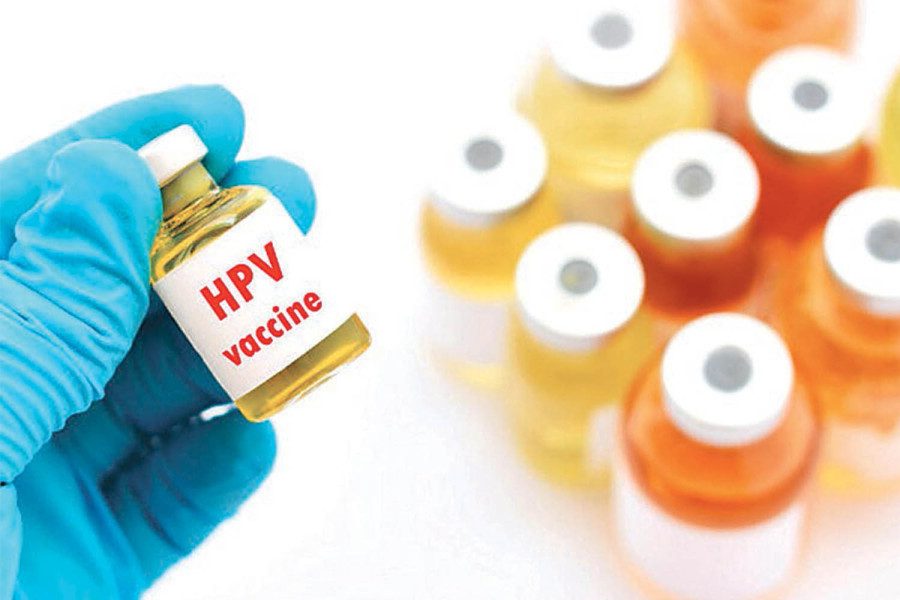Health
Health ministry includes HPV vaccine in routine immunisation drive
Around 350,000 girls aged 10 years will be administered the HPV vaccine at their schools, official says.
Post Report
Nepal has decided to include human papillomavirus (HPV) vaccine in its routine immunisation programme.
With the inclusion of the HPV vaccine, the number of antigens provided to children under routine immunisation will reach 14.
“Based on the recommendation of the National Immunisation Advisory Committee, we have decided to include the HPV vaccine in the routine immunisation programme,” said Dr Abhiyan Gautam, chief of the Immunisation Section at the Family Welfare Division of the Department of Health Services.
“Around 350,000 girls aged 10 years will be administered the HPV vaccine at their schools across the country.”
Human papillomavirus is a viral infection that spreads through skin contact and is a major cause of cervical cancer. Cervical cancer is the second-most common cancer in the developing world and a major cause of death among Nepali women. It is estimated that hundreds of women get diagnosed with cervical cancer in Nepal every year.
According to the BP Koirala Memorial Cancer Hospital in Bharatpur, more than 700 women suffering from cervical cancer seek treatment at the hospital every year.
Experts say early treatment can prevent up to 80 percent of cervical cancer cases.
Countries like Bhutan, Sri Lanka, Thailand and the Maldives have introduced HPV vaccines nationally, while India and Indonesia have introduced them in some districts.
In 2016, Nepal piloted HPV vaccines in Chitwan and Kaski districts. During the pilot, all girls aged between 11 and 13 years were given two doses of the vaccine.
Last year, the country purchased 20,000 doses of the HPV vaccine and administered it to around 9,000 girls aged between 14 and 15 years in all seven provinces. Health authorities administered the vaccines at schools after other measures failed to increase the vaccine’s uptake.
Doctors say most cases of cervical cancer are linked to HPV, and widespread immunisation could significantly reduce the impact of cervical cancer and other HPV-related cancers worldwide.
The Ministry of Health and Population has been preparing to launch a nationwide HPV vaccination drive from February 5 next year.
During the nationwide campaign, over 1.68 million girls between 10 and 14 years will be administered the human papillomavirus (HPV) vaccine.
“All eligible girls aged between 10 and 14 years will be vaccinated during the campaign,” said Gautam. “The vaccine will be administered in two doses over 12 months, with one dose given at the start and the other after 12 months.”
The Global Alliance for Vaccine and Immunisation (GAVI) will supply doses of the human papillomavirus (HPV) vaccine soon and has also provided for the campaign’s operation cost, officials say.
Nepal has to cover a certain percentage of the cost of the vaccine once it is included in the regular immunisation list, officials say.
Gautam said that routine immunisation will start only after the completion of the vaccination drive. The Nepal government and the GAVI will co-finance the vaccine cost of routine immunisation.
Childhood immunisation is the government’s number one priority. Under this, 13 types of antigens are given against a range of diseases, including measles-rubella, pneumonia, tuberculosis, diphtheria, pertussis, tetanus, hepatitis B, rotavirus, Japanese encephalitis and typhoid, free of cost.
“The number of antigens in routine immunisation will reach 14 once the HPV vaccine is started to be administered to the target group,” said Gautam.
Regular immunisation is one of the most successful programmes in Nepal, with a high coverage rate. The country has shown remarkable progress in reducing the under-five mortality rate, and the regular immunisation programme is credited with that.
The World Health Organisation says HPV vaccination is recommended as part of a coordinated strategy to prevent cervical cancer and other diseases caused by the virus.




 10.12°C Kathmandu
10.12°C Kathmandu













